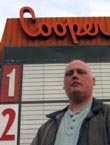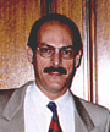|
|
 
|
|
Author
|
Topic: Prairie Home Companion
|
Mark Lensenmayer
Phenomenal Film Handler

Posts: 1605
From: Upper Arlington, OH
Registered: Sep 1999
|
 posted 06-09-2006 09:42 PM
posted 06-09-2006 09:42 PM




As an inhabitant of the Southern Mid-West, I find a quiet comfort in PRAIRIE HOME COMPANION. This is a great afternoon film, one to just enjoy the beauty and wit of Garrison Keillor's writing.
While this appears to be a simple tale of the end of a radio series, it has a very dark side about death and the end of things.
Virginia Madsen is the best angel since the glorious Jessica Lange in ALL THAT JAZZ (which is still the sexiest, fully-clothed performance I've ever experienced). Kevin Kline is the great Guy Noir, and he shows why he should have been Inspector Clouseau. Streep and Tomlin sing very well, and even Lindsay Lohen was better than OK.
My favorites in the film are Dusty (Woody Harrelson) and Lefty (John C. Reilly). They have a great time performing some mildly dirty songs, much to the displeasure of the stage manager. Yes, they are indeed the "Pachelbels of the Prairie" (My favorite line from the film.)
Keillor is Keillor. He doesn't have to really act, just be himself. Still, he is an essential part of the movie.
Unsung hero of the film is sound effects guy Tom Keith. He has a couple of great spots.
It is nice to see a film with live singing. It adds to the authenticity of the film, and fits Altman's style. Also nice to hear singing that is pure and simple, not overwrought as we hear on AMERICAN IDOL.
This won't do great business, and it won't go down in history as a great picture. It's also a film a lot of people won't like. But it was, for me, a wonderfully pleasant way to spend a late afternoon in late spring. It's one of my favorite films of the year, so far.
One might even say about this film, "Heavens, its tasty."
| IP: Logged
|
|
Mike Schindler
Phenomenal Film Handler

Posts: 1039
From: Oak Park, IL, USA
Registered: Jun 2002
|
 posted 06-09-2006 11:25 PM
posted 06-09-2006 11:25 PM




Altman's movies from THE PLAYER through DR. T AND THE WOMEN were all fairly awesome. But then he made GOSFORD PARK and THE COMPANY, and it's like, what happened? I was worried that he was finally getting old. But he offered some definite promise there a couple years ago with TANNER ON TANNER, and now a little more with A PRAIRIE HOME COMPANION. So it looks like he's at least on his way to returning to greatness.
This movie wasn't bad. I can't stand the radio show, and the idea of it ending appeals to me. But beyond that, the movie certainly has that Altman touch, which I think more than anything else comes in the editing.
Some things didn't work. Kevin Kline's character was a bit too on the nose in a movie which did not offer any support for that style. And Virginia Madsen's character was handled very clunkily. Also, the photography was not up to Ed Lachman's usual standards. I think he hasn't quite figured out how to use HD yet, and it shows. There is video artifacting all over this movie, which is very inappropriate for the material.
One last thing: Apparently, Altman originally wanted the two brothers to be played by Lyle Lovett and Tom Waits. It's a damn shame that that didn't work out.
| IP: Logged
|
|
John Koutsoumis
Master Film Handler
Posts: 261
From: Melbourne, Victoria, Australia
Registered: Aug 2003
|
 posted 06-13-2006 03:55 AM
posted 06-13-2006 03:55 AM




I screened this the other week. Wasn't too bad but it sure went on a bit too long.
I wouldn't exacxtly called it artifacting. Many Cinematographers do "film done wrong" as well. To me it looked better that the HD work on "Star Wars EP 2" and "Collateral" and a few other smaller HD movies i've seen over the years.
A.S.C Magazine
by Jon Silberg
quote:
Lachman shot Prairie on high-definition (HD) video using three Sony HDW-F900/3 cameras. All of the bodies were cabled via fiber to digital-imaging technician Ryan Sheridan’s workstation, where the HD-SDI signal from each camera was recorded to HD SRW-1 decks. Though the 4:2:2 signal could not take advantage of the SR format’s 4:4:4 capability, it could remain 10-bit linear rather than being compressed to 8-bit, the standard for recording in the HDCam format. This was the primary reason for the SR decks, explains Sheridan. “Because the 10-bit signal has less compression, we could manipulate it more on set or during post without getting noise in the blacks,” he says. “HDCam can get noisy fast, especially when you’re doing a [2.40:1] center cut and blowing it up for [theatrical] release.”
Sony’s HDC-F950 could have captured an even more robust 4:4:4 signal, but it was considerably more expensive to rent. During prep, Lachman tested it alongside the F900; footage from each model went through digital color correction and was recorded out to 35mm. “There isn’t a significant difference [in image quality] with the 4:4:4 camera, unless you’re doing bluescreen work or plan to dramatically alter the colors in post,” he reports.
Everything went through Sheridan’s station on set, where he had Sony MSU 750 controllers at his fingertips. “We could adjust the settings for gamma, black gamma, iris and contrast,” explains Sheridan. “We left our blacks up a little bit to keep more information there than we would have if it weren’t going out to film. When you’re planning to do a filmout, it’s important to maintain that control and leave more detail in the blacks than you ultimately want to see in the final product.”
For Lachman, who had never worked with HD before, the big question was how much he would need to adjust his usual methods to get the look he wanted from the digital format. As evidenced by his work on such films as Far From Heaven (see AC Dec. ’02), Erin Brockovich and The Virgin Suicides, Lachman has spent years shooting with various negatives and using gels to establish color contrast in a scene; he generally prefers to significantly overexpose his negative and then print it down to heighten color and contrast. For Prairie, he had to determine how to translate his methods to HD.
Testing the HD cameras gave him a firsthand look at the medium’s well-known difficulty with maintaining detail in highlights and impressive ability to hold detail in shadows. “It was a lot like 30 years ago, when I started out shooting Ektachrome and Kodachrome stocks,” says Lachman. “I had to expose for highlights rather than shadow detail. The camera is very good with shadow detail, but it doesn’t like highlights or even mid-tones very much in certain lighting and color palettes.”
In addition to working with the camera’s settings, Lachman notes that it’s important to apply look-up tables (LUTs) to the image data before it’s transmitted to the monitors. That whole path must be spot-on, and the monitors perfectly calibrated, in order for the monitors to serve as an accurate visual reference. So although the HD monitors helped Lachman confirm what kind of exposure, color and contrast he was getting at a given point, he still used his spot meter to analyze his lighting ratios; he believed the meter provided a more accurate measure than the monitors. “When you work in HD, you’re only as good as the technicians you’re working with, and Ryan was very good,” says Lachman. “He helped the production immensely, but I still might not know exactly what he was doing in different lighting situations from day to day. My spot meter gave me something I knew I could go back to day after day.”
Once Lachman and Sheridan worked out some basic settings on the F900, Lachman decided to “rate” the camera’s sensors at EI 500-1000 because he liked the look he got by putting more picture information in the shadow areas. “The highlights would start to burn out with 1 1/2 stops of overexposure and would hold shadow detail at 2 1/2 or even 3 stops under,” says the cinematographer. “I used that as a range so I could be consistent every day without relying upon the monitor. My gaffer, John DeBlau, would laugh when he saw me with my light meter and say, ‘Why not use the monitor? What you see is what you get.’ But I wasn’t convinced that was always true.”
quote:
Lachman also found he had to alter his habit of creating color with lighting because of the way HD renders hues. “I generally work with a lot with gels, and I like to manipulate color temperature. I use color contrast within the frame, and it’s very important to me how one color plays against another and how that comes back on film. I discovered that digital [sensors] were more responsive to some of my gels and less responsive to others than film. For example, purples and blues responded differently than they do on film, warm colors tend to bleed if they’re very saturated, and some portions of the green spectrum can be very hard to capture. As a result, I had to do a lot of experimenting with gels to get the results I was after.”
Lachman did little digital “painting” on set with the Sony controller because he wanted to leave his postproduction options open. Sheridan did work with LUTs downstream from the recording in order to create an image on the monitor that would approximate the final look. Nevertheless, Lachman wanted to retain as much information as possible on tape so he could, for example, fine-tune the blacks in post.
quote:
Most of the story takes place in real time during Keillor’s farewell radio broadcast, so a lot of the action occurs onstage and backstage. Lachman notes that the ability to cover scenes in long takes from multiple angles, with action happening in different planes of the frame, was the primary advantage of shooting in HD. “We decided to cover the performances like a concert film,” he says. “We controlled and limited the stage lighting that was there, and we usually had three cameras running at once. One was on a Super Technocrane and was operated by Robert Reed Altman, and two [operated by Pete Biagi and Michael St. Hilaire] were on dollies elsewhere in the theater.”
I know it may seem a bit much but it's interesting to read how/why things look a certain way that they do. Well I have interest in it anyway.
| IP: Logged
|
|
Mike Schindler
Phenomenal Film Handler

Posts: 1039
From: Oak Park, IL, USA
Registered: Jun 2002
|
 posted 06-13-2006 10:10 PM
posted 06-13-2006 10:10 PM




I actually read that article shortly after posting my review. The "artifacting" that bothered me is the bleeding that occurs with certain intense colors that Lachman refers to in the article. I don't think he wanted it to be there, and it's not in keeping with the sort of antique look of the rest of the movie.
I thought that COLLATERAL and STAR WARS, on the other hand, were very pretty movies. I especially love the look of COLLATERAL. It seems that video exaggerates color temperatures giving things with lots of mixed light, like cityscapes, a very colorful look. Maybe that's not the case. It's just something I've observed. But either way, it's cool.
But I think these cases are a good example of how with film and HD, one is not necessarily better than the other. They have two different looks, and it all depends on the effect you're going for. I hope that neither goes away anytime soon.
| IP: Logged
|
|
|
|
|
|
|
|
|
|
|
|
|
|
Mark Gulbrandsen
Resident Trollmaster

Posts: 16657
From: Music City
Registered: Jun 99
|
 posted 07-12-2006 08:37 AM
posted 07-12-2006 08:37 AM




quote: Mike Schindler
I thought that COLLATERAL and STAR WARS, on the other hand, were very pretty movies. I especially love the look of COLLATERAL.
I couldn't agree more with that statement. Collateral pretty much defines how good a digitally shot film can look. And this is now considered to have been done with "Old" digital cameras!
quote:
Testing the HD cameras gave him a firsthand look at the medium’s well-known difficulty with maintaining detail in highlights and impressive ability to hold detail in shadows. “It was a lot like 30 years ago, when I started out shooting Ektachrome and Kodachrome stocks,” says Lachman. “I had to expose for highlights rather than shadow detail. The camera is very good with shadow detail, but it doesn’t like highlights or even mid-tones very much in certain lighting and color palettes.”
I love this paragraph... video imagers of all types have been this way since the image dissector was invented... where has this guy been living for the last 50 years, surely he has worked with a TV camera at some point in his life....? Color reversal films of all types have alot higher contrast than normal and one ALWAYS has to expose for the highlights or just shy of that.. or loose whats in them. Amother option for mid tones and shadows is to flash the film, either before or after exposure to give it that pseudo lower contrast effect... or as I call it a washed out mess. Almost all 3 tube or ccd TV cameras have bias lights in the prism block... I wonder if todays HD cameras retained that feature since it could be used effectively to control contrast very accurately.
As for the film the only part I liked was the song that refered to Red Lodge (MT) since I've been there a hundred times and also service the theater there. Very appropriate to the film but otherwise for me the film didn't have enough skin, tits, and ass, and no R rating ![[Wink]](wink.gif) . .
Mark
| IP: Logged
|
|
Ron Keillor
Expert Film Handler

Posts: 166
From: Vancouver, B.C. Canada
Registered: Jul 2003
|
 posted 07-23-2006 02:37 PM
posted 07-23-2006 02:37 PM




Cinemark Tinseltown Vancouver, B.C. #6 Thurs. July 20, 7:20 pm
Attendance 14, mainly seniors - PHC is not carried on local radio altho Seattle's KUOW (NPR station) did bring the show here about a dozen years ago. The audience then was mainly from Seattle and Bellingham who chartered an AMTRAK train for the round trip.
I"m not an Altman fan, but a PHC fan, and thought the success of the film came from having a stronger contribution from the script.
Kevin Kline seemed to be doing an imitation of Steve Martin, there's no 'News from Lake Woebegon'*, an highlight of the broadcast. It's nice now to be able to visualize the radio crew, but the timeless feeling of the broadcast has been lost - this is not a film for a youth market.
The presentation was excellent - cleanest edges I have ever seen. And if the HD recording was the way of avoiding the grain bounce that was in one of the trailers (something from Universal with an unbearable volume level), then it is progress, even at the loss of really dark blacks. There was no intermission music, a touch which this audience probably appreciated very much.
*a good thing. Stopping the show for a 15 minute monologue is fine on radio but would be deadly on film.
[ 07-23-2006, 09:19 PM: Message edited by: Ron Keillor ]
| IP: Logged
|
|
|
|
All times are Central (GMT -6:00)
|
|
Powered by Infopop Corporation
UBB.classicTM
6.3.1.2
The Film-Tech Forums are designed for various members related to the cinema industry to express their opinions, viewpoints and testimonials on various products, services and events based upon speculation, personal knowledge and factual information through use, therefore all views represented here allow no liability upon the publishers of this web site and the owners of said views assume no liability for any ill will resulting from these postings. The posts made here are for educational as well as entertainment purposes and as such anyone viewing this portion of the website must accept these views as statements of the author of that opinion
and agrees to release the authors from any and all liability.
|

 Home
Home
 Products
Products
 Store
Store
 Forum
Forum
 Warehouse
Warehouse
 Contact Us
Contact Us




 Printer-friendly view of this topic
Printer-friendly view of this topic








![[Cool]](cool.gif)



![[Wink]](wink.gif)

![[Smile]](smile.gif)
![[thumbsup]](graemlins/thumbsup.gif)
![[thumbsdown]](graemlins/thumbsdown.gif)
![[puke]](graemlins/puke.gif)
![[fu]](graemlins/fu.gif)





